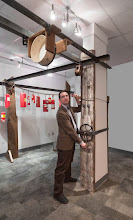A diminutive woman of perhaps fifty, Chizuko has clearly shown a lot of people this market, and obviously delights in doing so. She has the sort of pride in her city that a lot of people have about their own cities, and the Nishiki Market is such a special place that I think it must bring her great joy to watch people discovering it.
As we went through she bought a few things, a package of nori here, some pickles there. At the end of the market is Nishiki Tenmangu, a Shinto shrine that is dedicated to academic excellence. In addition to being Buddhist, Chizuko also follows Shinto traditions, so we stopped in there and said a prayer. Then we went to Chizuko's house.
She lives in a small apartment on the 6th floor of a pretty modern apartment building. Not unlike apartment buildings that I have been in in the States: no moulding, taupe walls. Normal. Her kitchen is stacked with stuff, and she obviously not only teaches cooking but loves to cook.
She patiently led us through making dashi or Japanese soup stock, and then sushi rice. Like everyone here she has a rice cooker, of course, but she also soaks the rice for a while with a piece of kelp before making the rice. She would not do this, she explained, for regular rice, this was the process for sushi rice. When it comes out of the cooker, a vinegar and dashi mixture is added, and an important part of that process is apparently fanning the rice. It "makes it shiny," she claims. She said smiling that in a restaurant that is the job of the apprentice. Or an electric fan.
We ground sesame to make a dressing for some steamed spinach. When it had been applied one of the students said that she hated spinach and never ate it, but that with this dressing it was so good she wanted to go home and make it. I call that a victory. So important to remember that sometimes we just need a change of context to find our way forward.
The last thing to make was a traditional style omlette, which is made in a square pan. The egg mixture (eggs, dashi, and some "light-colored soy sauce") is spread thinly in the pan and then rolled up. You can roll vegetables into it, she said, but you don't have to. For the sushi we did not.
Once we had all of that, it was time to make the miso soup. Miso paste was strained into a pot of dashi (nothing doesn't have dashi in it, apparently. I bet it is even in ice cream), and tofu and seaweed added. "That's it!" Chizuko was clearly trying to impress upon us how easy this cooking is "That's all you have to do! Now, please when you go home you will make miso soup. It's very easy and very good for you."
Once everything was prepared she showed us how to roll it into the nori and how to cut it. And then, of course, we ate it. And it was so good.
For some of my students, this was their first ever cooking adventure. I asked if they didn't cook with their parents when they were young and a couple said no, they never had, which surprised me. It put me in mind of the cooking classes my mom ran for me and my friends when I was maybe 8 or 9 years old, making spaghetti or pizza. Nothing fancy, but she led us through making and then eating food just like Chizuko did. I thought everyone had some similar story of helping in the kitchen, but apparently not.
There is something so satisfying about eating your own food. the students were really moved by it. Even the ones that had done some cooking had not done anything like this, and now rolling that sushi is in their hands and their minds, and the connection is there between a physical activity, a skill, and nourishment. It really is one of the best lessons, and they all were so satisfied with themselves and with the food. It was lovely to see.
 |
| Rollin' rollin' rollin'. |
 |
| Making good food. |
 |
| Cutting the sushi. |
 |
| My miso, sushi, and salad. Delicious. |


No comments:
Post a Comment